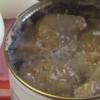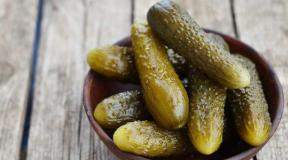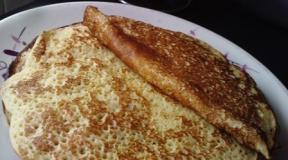All the most interesting about cotton candy. The history of cotton candy or a sweet fairy tale of childhood
Who invented the cooking machine cotton candy?
A product from childhood, which we know as cotton candy, is called differently in other languages.
In America it is called cotton candy, which is closest to ours - cotton candy, although earlier in the USA a different name was adopted: fairy floss - magic fluff, however, as now in Australia. And in England, something in between these two took root: candy floss- sweet fluff.
In France, cotton candy is called barbe a papa, i.e. father's beard, in Germany - Zuckerwolle, or sugar wool (yarn), in Italy - zucchero filato, i.e. sugar yarn (thread).
Modern machine for making cotton candy at home
Confectionery in the form of threads obtained from melted sugar has been known for a long time. There are stories (legends) that the ancient Romans had slaves who knew how to make such sweets. If there is any truth to this story, it makes cotton candy one of the many technologies lost during the Middle Ages. This art was revived (or first appeared) in the middle of the 18th century. But the manufacturing process was manual, extremely laborious, as a result of which this product was expensive and therefore inaccessible to common man. In the East, similar confectionery e.g. Persian pashmak and Turkish Pismaniye although the latter is made with flour in addition to sugar.
In order for a product to become mass, it must be cheap. With raw materials, in this case, there are no problems - sugar is relatively cheap and little is consumed per serving. The problem is the complexity, the speed of production. To make cotton candy truly a mass product, it was necessary to mechanize the process of its production, i.e. create an apparatus or machine for the rapid manufacture of this product. And such a machine was created in the USA at the end of the 19th century.
Invented a machine for making cotton candy William Morrison (William Morrison) And John Wharton (John C. Wharton), the filing date of the application for which (12/23/1897) is considered the date of invention of the device. The method of production and the installation itself are simple to the point of genius. The molten sugar heated by a gas burner, located in a rotating container, was forced through a series of small holes or a grid on the periphery of this container due to centrifugal force. Picked up by the air flow from the compressor, thin streams of molten sugar instantly crystallized in the form of thin threads, similar to cotton wool or wool, and were collected by the operator on a wooden or cardboard stick in the form of a ball. The rotation of the sugar container and the air compressor was carried out using a foot drive, similar to the drives of sewing machines.
The first plant for the production of cotton candy, 1899.

The first electric apparatus for the production of cotton candy, 1903.
To familiarize the public with the new product, the inventors chose the 1904 trade show in Louisiana, otherwise known as the World's Fair in St. Louis, in the materials of which it was recorded that Electric Candy Company earned $17,164 by selling 68,655 boxes of cotton candy (370 boxes for each day of the show) at a price of 25 cents.
Named Inventors Fairy Floss and packed in bright chipped wood boxes (probably made of wood or veneer), New Product enjoyed great popularity, even despite the high price for that time. Suffice it to say that the entrance ticket to this fair, with access to all its attractions, cost 50 cents, and some department stores of that time advertised men's shirts for 25 cents.
It should be said that the 1904 World's Fair in St. Louis was a significant event not only for America, but perhaps for the whole world. If we talk only about food products, then it was at this fair that, in addition to cotton candy, the famous sandwiches also appeared for the first time. Hot Dogs, cold tea (iced tea), waffle packaging for roller and cone ice cream, confectionery products with peanut butter, i.e. these are products without which it is difficult to imagine modern America.
After this exhibition, the cotton candy industry began to develop rapidly.


For such production, which is already mass, completely different devices are needed, namely automatic machines that would continuously produce cotton candy, divide it into portions and transfer it to packaging. And such machines were created.
Over time, cotton candy has, of course, changed. A great achievement in the development of cotton candy production technology is the appearance of color, smell and taste in this product. Today, we are very suspicious of artificial colors and flavors, and therefore these achievements look dubious. And yet, packaged cotton wool made from pure sugar is now difficult to find.

More than a hundred years have passed since the invention of the apparatus for the production of cotton candy.
Although the principle of making cotton candy has not changed much, the technique and technology have gone far ahead compared to the first machines. This type of business has gone very far from the fair tents, turning into a whole area of the food industry. However, even now, somewhere with a mass gathering of people, you can see a cotton candy seller with his apparatus, surrounded by children and their parents. Someone starts their business in this way, someone remembers their childhood, and someone just enjoys life.


Why this happens: when we have cotton candy in our hands, we all turn into children! Maybe its original name - magic fluff - was the most accurate? ..




Veronica Trifonenko.
Sugar lips, cotton candy.
Big eyes and sweet too.
I count the poles and greenery in the fences.
And the sky is such that it is loud and a lot.
I feel so good and it seems possible
Burn, dissolve, become something else.
Touching again sweet dreams.
Smiles and glances, a shared secret
Not hidden by darkness. The Secret of Happiness.
Laughing and looking for something with your eyes.
I don't know, it's just magic.
Once again smile, drown in a kiss.
Now I'm alive. Amen. Hallelujah.
When you think of a holiday park, what comes to mind? Breathtaking rides? Fun, exciting games? What about that fluffy, sweet treat called cotton wool? If you have ever tasted cotton candy, then you are familiar with a very light and melting taste in your mouth. Who came up with this culinary product how is it made and is there any use in it?
The history of the invention of sweet treats
The machine that spins cotton candy was developed in 1897 by William Morrison and John Wharton. The world's first cotton candy machine was invented by two confectioners from Tennessee.
In 1904, Morrison and Wharton demonstrated their development for the production of cotton candy at the St. Louis Fair. They sold a portion of sweets for 25 cents. Although such a price may seem small, but then it was half the cost of an entrance ticket to the fair!
Although people may have thought that the sweet was expensive enough, they were willing to pay for the novelty. Morrison and Wharton sold over 68,000 portions of cotton candy at the fair.
The demand was really great, but the first machines were very unreliable. They rattled and often broke.
In 1949, the manufacturer "Gold Medal Products Company" from Cincinnati, USA, introduced a new model of the machine, which became very popular. Today the company satisfies almost all market needs in such devices.
How cotton candy is made
So what happens inside the cotton candy machine? First, sugar is melted to a liquid state. Then liquid sugar formed by a machine and pushed through tiny holes that form fibers and then cooled. After the cotton wool has cooled, the mass becomes solid again.
Thousands of tiny strands of crystallized sugar wrap around a paper cone inside the machine. Once the cotton candy has gained its weight and size, it is ready to be eaten!
And how does cotton candy turn pink or blue color? Many will be surprised to learn that cotton wool, like sugar, naturally has White color. pink and blue colors obtained by adding food coloring.
The benefits and harms of cotton candy
Knowing the composition of cotton candy, it is easy to answer questions about its harm and benefits. And these answers, alas, are quite disappointing for lovers of sweet treats. It's not for nothing that sugar is called " White death". And cotton wool from it, of course, is no better.
Nothing useful, except for "empty" calories, it does not contain. Let's add everyone here known harm for teeth and figure. And the dyes contained in the color variations of the treat only exacerbate the situation.
Sweet facts about cotton candy
- Cotton candy has its own special day. In the US, it is celebrated on November 7 every year.
- There is only one ingredient in cotton candy: sugar.
- One serving of cotton candy contains as much sugar as a can of soda.
It is fluffy, bright, airy and delicious. And it is also a favorite delicacy of adults and children. You have already guessed that we are talking about cotton candy. Probably, you are still fascinated by the process of preparing this product. We've all seen it done when we were kids. We all made amazed eyes when a huge air mass swelled from one small sugar lump. But as adults, we still see it as a magic trick. Why does cotton candy have an airy texture and why does it have different shades? Here are a few interesting facts from the history of the popular delicacy.
Two main secrets
Despite the fact that the product is almost 100 percent sugar, it has a lot of fans. The reason for this is a whole bunch of unique flavors and a surprisingly delicate texture. If you fill this cotton texture with milk, strawberry, vanilla or grape syrup, you will get a real confectionery miracle. Cotton candy is several times more popular than caramel, chocolate candies and cookies. Perhaps you will not find a more stellar delicacy in the world. 
First public appearance
The first cotton candy machine was presented at the St. Louis World's Fair in 1904. Eyewitnesses did not remember other inventions. One of them was so cunning that it immediately attracted attention. A metal drum appeared before people, which rotated very quickly due to centrifugal force. When a slightly melted lump of sugar was placed in the container, the magic began. A simple ingredient turned into thin long threads, which gradually gathered into a ball. Interspersed with the air layer, the sugar stretched and formed many sticky fibers. To give the resulting canvas a shape, the master armed himself with a stick and rolled the threads into a cone. As they say, everything ingenious is simple.
Many names
IN different countries around the world this delicacy is called differently. For example, in Italy it is “sugar yarn”, and in China and Japan it is “old woman's hair”. The French call cotton candy "grandfather's beard", and somewhere it is called "tooth fairy". 
Who invented the cotton candy machine?
Ironically, the inventor of the product was a dentist named William Morrison, who once volunteered to help his pastry chef friend John Wharton.
Medieval confectioners made dessert by hand
Starting from the 15th century, the best European confectioners tried to produce the delicacy by hand. The process was so laborious that only the most noble and wealthy members of society could afford "sugar yarn". Just imagine that each fiber from the sugar melted in the pan was stretched with the help of forks by hand! We can assume that the invention of William Morrison gave way to the product to the masses. 
Bright hit at fairs and carnivals
Tradition since its inception air treat sold at mass sporting events, carnivals and fairs. Modern options provide bright colors that are achieved through dyes.
WHAT IS THE ARTICLE ABOUT?
Where did she come from?
It is believed that cotton candy appeared in the 15th century. The ancient Romans had specially trained people who prepared this delicacy for various holidays. But in this case, this technology is one of the lost ones, since new mentions of cotton candy only date back to the 18th century. In Europe, there were mechanical machines that prepared a delicacy similar to modern cotton candy. But the cooking process was very time consuming.
Cotton candy is a delicacy made from fine fibers of sugar or sugar syrup wound around thin base. Therefore, cotton candy is so airy and voluminous. Technological process will be discussed below.
Composition and production process
In order to prepare cotton candy, you need the following raw materials:
- Sugar
- Vinegar
- Water
- Dyes
The production process begins with the melting of sugar in a special machine. Then water is supplied with a very small concentration of vinegar. Thus is prepared sugar syrup. Optionally, dyes and preservatives are added to it.
The prepared raw materials are fed to a centrifuge, which spins the syrup and feeds drops of it under pressure through the smallest holes. Flying out, the drops begin to cool and solidify. At this moment, they are wound onto the base in the form of a thin stick, which makes it possible to form long and thin fibers from the hardening syrup. The fibers are wound on each other to the desired volume of the product and the process ends. The product is then packed in a special machine.
Devices and their cost
It is believed that the first cotton candy maker was invented in 1987 by William Morrison and John Wharton. They presented to the public an apparatus that prepared a new delicacy in automatic mode. This device consisted of:
- A gas burner that melted sugar
- Syrup mesh centrifuges
- An air compressor that distributed the fibers to the warp and formed the cotton candy
The device discussed above was mechanical, but progress did not stand still. Already in 1903, an electric cotton candy machine was invented, and the industry received a big boost in development.
The range of modern devices for cotton candy is very wide. Consider the most popular of them.
| Name | Description | Price |
|---|---|---|
| Gold Medal - Econo Floss | Its height is 40 centimeters and its diameter is 65. It has a small weight - only seventeen kilograms, which makes it great for beginners. In terms of electricity consumption, it is comparable to a kettle and is powered by a conventional 220 volt network. For an hour of work, you can wind up about two hundred portions of 15 grams, and these are medium-sized balls. | 35-39 thousand rubles. |
| Gold Medal - Tornado | The second device is called TORNADO, and is also produced by GOLD MEDAL. It is much more productive and larger than the first model. It is 85 by 60 centimeters, and its height is sixty-five centimeters. The weight is 35 kg. Productivity keeps at the level of 600 portions of the average size (15 grams) an hour. Cost per Russian market is about 60 thousand rubles. | 60 thousand rubles |
For street trading there is also great amount domestic devices. They are characterized by a small capacity of 60-80 portions per hour. You can buy them in the region of 10 thousand rubles.
DIY cotton candy
At home, you can cook cotton candy both on the machine and without it. You can buy a special cotton candy machine, which will cost about 1,500 rubles, or make it yourself.
Algorithm for making a homemade cotton candy machine:
- cook metal lids from baby food or make blanks similar in size.
- Use a file or sandpaper to remove the protective coating and paint. They should not get into the cotton when used.
- In one of the lids, make a large hole for falling asleep sugar, and in the other many small ones for serving the finished syrup.
- Connect the covers together with wire or in another way so that there is a space of 5 centimeters between them.
- Attach a motor from a mixer or hair dryer to a rigid base, and then to a lid with small holes. Connect the battery to the crown.
- Cover the space around the lids with cardboard.
- The device is ready! Now you can add sugar and collect the melted syrup from the walls.
There is not always a desire to do homemade products, but there is a desire to cook cotton candy at home. You can try to make it without a typewriter:
- Mix sugar and water in a ratio of 3 to 1.
- Add 3 drops of 6% vinegar (may need up to 7 drops if cotton won't come out)
- Prepare sugar syrup on the stove. Make sure it doesn't burn.
- Then you need to cool the syrup to 35 degrees. Make sure it doesn't freeze.
- It is necessary to heat and cool the syrup about 6-7 times until it becomes homogeneous and viscous.
- After the syrup is ready, you need to create threads from it. To do this, take a lot of thin sticks and wind the syrup between them in different directions until you get the right amount.
Cotton candy is one of the most popular sweets around the world. In America, it was nicknamed "cotton sweetness" (cotton candy), in England - "magic silk thread" (fairу floss), in Germany - "sugar wool" (Zuckerwolle), in Italy - "sugar yarn" (zucchero filato), in France - "grandfather's beard" (barbe a papa).
Despite legends that sweets like cotton candy were produced in ancient Rome, but were extremely expensive due to the complexity of production, no evidence of this has been found. but it is documented that the date of birth of cotton candy is 1893. It was in this year that William Morrison and John C. Wharton invented the cotton candy machine. This is evidenced by US patent No. 618428, the filing date of the application for which (12/23/1897) is considered the date of the invention of the cotton candy apparatus.
The method of production and the installation itself are simple, almost to the point of genius. The molten sugar heated by a gas burner, located in a rotating container, was forced through a series of small holes or a grid on the periphery of this container due to centrifugal force. Picked up by the air flow from the compressor, thin streams of molten sugar instantly crystallized in the form of thin threads, similar to cotton wool or wool, and were collected by the operator on a wooden or cardboard stick in the form of a ball. The rotation of the sugar container and the air compressor was carried out using a foot drive, similar to the drives of sewing machines.
To familiarize the public with the new product, the inventors chose the 1904 Louisiana Purchase Exposition, otherwise known as the 1904 St. Louis World's Fair, in the materials of which it was recorded that the Electric Candy Company made $17,164 by selling 68,655 boxes of cotton candy (370 boxes for each day of the show) at a price of 25 cents.
Named Fairy Floss by the inventors and packaged in colorful wooden boxes, the new product was hugely popular despite the high price tag for the time. Suffice it to say that the entrance ticket to this fair, with access to all its attractions, cost 50 cents, and some department stores of that time advertised men's shirts for 25 cents.
Virtually all sources state that the cotton candy sold at the St. Louis World's Fair was made on electric machines, and that Morrison and Wharton are the inventors of the electric machine for its production. But in patent #618428 there is no hint of the use of electricity, neither as heating nor as a drive. The thing is that by 1904 the apparatus had been significantly improved, including electrical heating.
As often happens, the tandem of cotton candy inventors, however, as well as their Electric Candy Company, did not last long. The reason for their break is unknown to me, but Morrison received the next US patent No. 816114 in March 1906 himself. The company was divided, renamed, but existed. Here is an advertisement for products from the Electric Candy Floss Machine Company, Inc. from the middle of the 20th century.
More than a hundred years have passed since the invention of the apparatus for the production of cotton candy. Although the principle of making cotton candy has not changed much, the technique and technology have gone far ahead compared to the first machines. This is not surprising, because. this type of business has gone very far from fair tents, turning into a whole area of \u200b\u200bthe food industry. However, even now, somewhere with a mass gathering of people, you can see a cotton candy seller with his apparatus, surrounded by children and their parents. Someone starts their own business in this way, someone remembers their childhood, and someone just enjoys life.





















